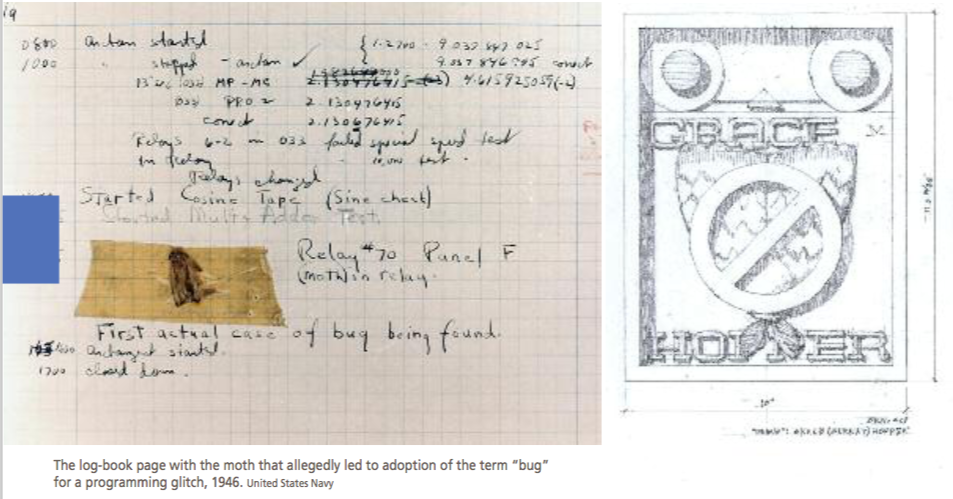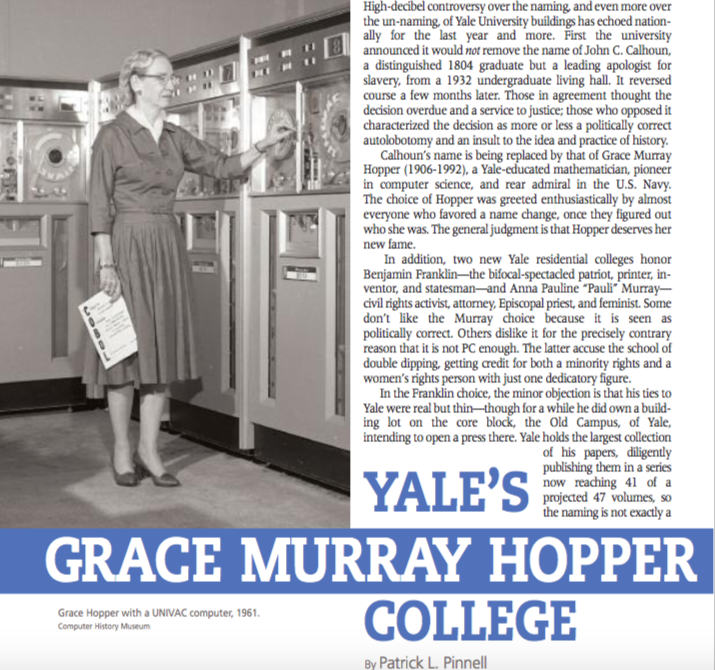SUBSCRIBE/BUY THE ISSUE
By Patrick L. Pinnell
(c) Connecticut Explored Inc. Fall 2017
High-decibel controversy over the naming, and even more over the un-naming, of Yale University buildings has echoed nationally for the last year and more. First the university announced it would not remove the name of John C. Calhoun, a distinguished 1804 graduate but a leading apologist for slavery, from a 1932 undergraduate living hall. It reversed course a few months later. Those in agreement thought the decision overdue and a service to justice; those who opposed it characterized the decision as more or less a politically correct autolobotomy and an insult to the idea and practice of history.
Calhoun’s name is being replaced by that of Grace Murray Hopper (1906-1992), a Yale-educated mathematician, pioneer in computer science, and rear admiral in the U.S. Navy. The choice of Hopper was greeted enthusiastically by almost everyone who favored a name change, once they figured out who she was. The general judgment is that Hopper deserves her new fame.
In addition, two new Yale residential colleges honor Benjamin Franklin—the bifocal-spectacled patriot, printer, inventor, and statesman—and Anna Pauline “Pauli” Murray—civil rights activist, attorney, Episcopal priest, and feminist. Some don’t like the Murray choice because it is seen as politically correct. Others dislike it for the precisely contrary reason that it is not PC enough. The latter accuse the school of double dipping, getting credit for both a minority rights and a women’s rights person with just one dedicatory figure.
In the Franklin choice, the minor objection is that his ties to Yale were real but thin—though for a while he did own a building lot on the core block, the Old Campus, of Yale, intending to open a press there. Yale holds the largest collection of his papers, diligently publishing them in a series now reaching 41 of a projected 47 volumes, so the naming is not exactly a hasty attempt to swipe Franklin from Philadelphia. The major objection comes from perception that the name is essentially a trade, a major donation for the new buildings having come from Charles B. Johnson, class of 1954, chairman of Franklin (yes, named after Ben) Templeton Investments.
Similar alumni grumblings are audible over renaming the main university dining hall, Commons, the Steven A. Schwarzman Center in thanks for a gift by Schwarzman, class of 1969 and cofounder of the Blackstone Group, a global investment firm. Some question naming the iconic central feature of the newly renovated 1932 Hall of Graduate Studies the David Swensen Tower, after the extremely effective chief financial officer of the university, who has taken Yale’s endowment to towering new heights. The latter three instances in particular have raised concerns that today’s Yale is increasingly swayed by money.
If harboring memory and fostering discovery are still two essential components of what institutions of learning are supposed to do, then who gets to remember and forget, and in turn be remembered or forgotten? Who gets to discover and be known for it?

(l) log-book page with the moth that allegedly led to adoption of the term “bug” for a programming glitch, 1946. United State Navy; (r) Patrick Pinnell’s design for an ornamental stone carving representing Grace Murray Hopper for Yale’s Franklin and Murray colleges. Courtesy of Patrick Pinnell
Grace Murray Hopper’s life and career present a combination of memory and discovery, tradition and innovation, that seem almost purpose-designed to give an answer, or at least answers, to those questions. Born in New York to an insurance executive father (Yale class of 1894) and a mathematician mother, she was genetically fated to numeracy. After a bachelor’s in mathematics and physics from Vassar, she earned Yale master’s and doctor’s degrees in mathematics. A few years later she joined the United States Navy Reserve to contribute her knowledge to the World War II effort. Her subsequent career was a complicated back and forth between navy service and private companies as she worked on development of programming languages. Her final military rank, following 42 years of service, was rear admiral.
 I was asked by Yale to propose topics for, and design, more than 200 ornamental stone carvings for the new Franklin and Murray colleges. One of them commemorates Hopper. It superimposes her name, in the original IBM logo typeface, on the front of a magnetic tape drive for an early Univac computer. Recognizing her legendary invention of the term “debug“ for fixing programming problems (originated in literally removing a crisped moth from a computer’s vacuum tubes), a head’s-down dead moth is covered by a traffic-sign symbol for “no” or “prohibited.” The whole also forms a face with mouth open in wonder at her achievements.
I was asked by Yale to propose topics for, and design, more than 200 ornamental stone carvings for the new Franklin and Murray colleges. One of them commemorates Hopper. It superimposes her name, in the original IBM logo typeface, on the front of a magnetic tape drive for an early Univac computer. Recognizing her legendary invention of the term “debug“ for fixing programming problems (originated in literally removing a crisped moth from a computer’s vacuum tubes), a head’s-down dead moth is covered by a traffic-sign symbol for “no” or “prohibited.” The whole also forms a face with mouth open in wonder at her achievements.
Patrick L. Pinnell is an architect, planner, and writer and a graduate of Yale College and the Yale School of Architecture. He is author of The Campus Guide: Yale University, an Architectural Tour (Princeton Architectural Press, 1999, second edition 2013). He wrote “Ingalls Rink and the Yale Bowl” in the Fall 2009 issue.

